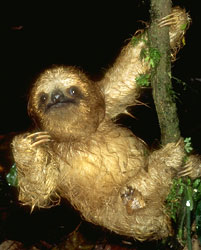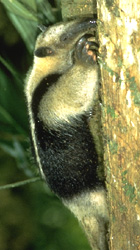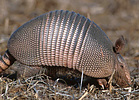Edentata
Anteaters, sloths, armadillos



This tree diagram shows the relationships between several groups of organisms.
The root of the current tree connects the organisms featured in this tree to their containing group and the rest of the Tree of Life. The basal branching point in the tree represents the ancestor of the other groups in the tree. This ancestor diversified over time into several descendent subgroups, which are represented as internal nodes and terminal taxa to the right.

You can click on the root to travel down the Tree of Life all the way to the root of all Life, and you can click on the names of descendent subgroups to travel up the Tree of Life all the way to individual species.
For more information on ToL tree formatting, please see Interpreting the Tree or Classification. To learn more about phylogenetic trees, please visit our Phylogenetic Biology pages.
close boxReferences
Barlow, J. C. 1984. Xenarthrans and pholidotes. Pages 219-239 in Orders and Families of Recent Mammals of the World. (S. Anderson and J. K. Jones, Jr., eds). John Wiley and Sons, N.Y.
Cartelle, C. and G. DeIuliis. 1995. Eremotherium laurillardi: The Panamerican late pleistocene megatheriid sloth. Journal of Vertebrate Paleontology 15: 830-841.
De Iuliis, G. 1994. Relationships of the Megatheriinae, Nothrotheriinae, and Planopsinae - some skeletal characteristics and their importance for phylogeny. Journal of Vertebrate Paleontology 14:577-591.
De Iuliis, G. and C. Cartelle. 1999. A new giant megatheriine ground sloth (Mammalia : Xenarthra : Megatheriidae) from the late Blancan to early Irvingtonian of Florida. Zoological Journal of the Linnean Society 127:495-515.
Delsuc, F., F. M. Catzeflis, M. J. Stanhope and E. J. P. Douzery. 2001. The evolution of armadillos, anteaters and sloths depicted by nuclear and mitochondrial phylogenies: implications for the status of the enigmatic fossil Eurotamandua. Proceedings of the Royal Society of London B 268:1605-1615.
Delsuc, F., M. Scally, O. Madsen, M. J. Stanhope, W. W. de Jong, F. M. Catzeflis, M. S. Springer and E. J. P. Douzery. 2002. Molecular phylogeny of living xenarthrans and the impact of character and taxon sampling on the placental tree rooting. Molecular Biology and Evolution 19:1656-1671.
Delsuc, F., M. J. Stanhope and E. J. P. Douzery. 2003. Molecular systematics of armadillos (Xenarthra, Dasypodidae): contribution of maximum likelihood and Bayesian analyses of mitochondrial and nuclear genes. Molecular Phylogenetics and Evolution 28(2):261-275.
Gaudin, T. J. 1995. The ear region of edentates and the phylogeny of the Tardigrada (Mammalia, Xenarthra). Journal of Vertebrate Paleontology 15:672-705.
Gaudin, T. J. 2004. Phylogenetic relationships among sloths (Mammalia, Xenarthra, Tardigrada): the craniodental evidence. Zoological Journal of the Linnean Society 140(2):255-305.
Höss, M., A. Dilling, A. Currant, and S. Päabo. 1996. Molecular phylogeny of the extinct ground sloth Mylodon darwinii. Proceedings of the National Academy of Sciences USA 93:181-185.
Montgomery, G. G., ed. 1985. The Evolution and Ecology of Armadillos, Sloths, and Vermilinguas. Smithsonian Institution, Washington, DC.
Nowak, R.M. 1999. Walker's Mammals of the World. Sixth Edition. Volume I. Johns Hopkins University Press, Baltimore.
Rose, K. D. and R. J. Emry. 1993. Relationships of Xenarthra, Pholidota, and fossil "edentates": the morphological evidence. Pages 81-102 in Mammal Phylogeny. Volume 2. Placentals. (F. S. Szalay, M. J. Novacek, and M. C. McKenna, eds.) Springer Verlag, New York.
van Dijk, M. A. M., E. Paradis, F. Catzeflis, and W. W. de Jong. 1999. The virtues of gaps: Xenarthran (Edentate) monophyly supported by a unique deletion in alpha A-crystallin. Systematic Biology 48:94-106.
Information on the Internet
- Order Xenarthra. Animal Diversity Web. University of Michigan Museum of Zoology.
- Xenarthra.Org.
- Ground Sloths. Illinois State Museum.
- Armadillo Online.
Title Illustrations

| Scientific Name | Bradypus variegatus |
|---|---|
| Location | La Selva Biological Station, Costa Rica |
| Comments | Three-toed sloth (Bradypodidae) in lowland rain forest |
| Copyright |
© 2000 Greg and Marybeth Dimijian

|
| Scientific Name | Dasypus novemcinctus |
|---|---|
| Location | Sequoyah National Wildlife Refuge, Oklahoma |
| Comments | Armadillo |
| Creator | John and Karen Hollingsworth |
| Specimen Condition | Live Specimen |
| Source Collection | U.S. Fish and Wildlife Service Online Digital Media Library |
| Scientific Name | Tamandua mexicana |
|---|---|
| Location | La Selva Biological Station, Costa Rica |
| Comments | Lesser anteater feeding on ants on tree trunk close to ground in lowland tropical rain forest. |
| Copyright |
© 2000 Greg and Marybeth Dimijian

|
About This Page
Page copyright © 2000
All Rights Reserved.
Citing this page:
Tree of Life Web Project. 2000. Edentata. Anteaters, sloths, armadillos. Version 01 January 2000 (temporary). http://tolweb.org/Edentata/15953/2000.01.01 in The Tree of Life Web Project, http://tolweb.org/











 Go to quick links
Go to quick search
Go to navigation for this section of the ToL site
Go to detailed links for the ToL site
Go to quick links
Go to quick search
Go to navigation for this section of the ToL site
Go to detailed links for the ToL site